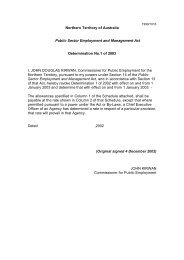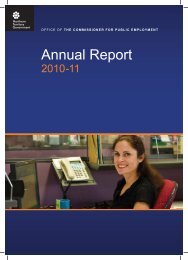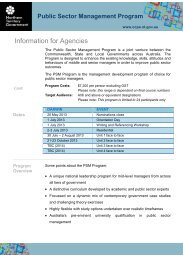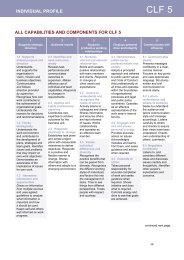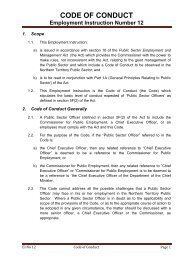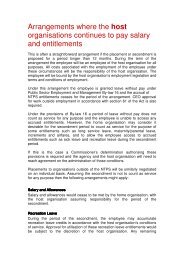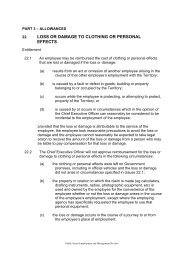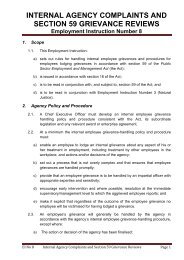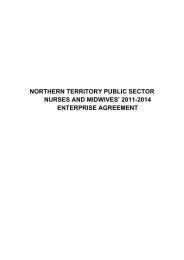Making Workforce Planning Work in the NT Public Sector
Making Workforce Planning Work in the NT Public Sector
Making Workforce Planning Work in the NT Public Sector
You also want an ePaper? Increase the reach of your titles
YUMPU automatically turns print PDFs into web optimized ePapers that Google loves.
O<strong>the</strong>r cohorts that should be monitored are:• employees who entered <strong>the</strong> agency through graduate programs• employees who entered <strong>the</strong> agency through targeted programs such as <strong>the</strong>Indigenous Employment and Career Development Strategy and Will<strong>in</strong>gand Able.<strong><strong>Work</strong>force</strong> cohorts – <strong>in</strong>dustryInformation about <strong>the</strong> ‘<strong>in</strong>dustry’ experience of employees allows workforceplann<strong>in</strong>g to more clearly target <strong>the</strong> tra<strong>in</strong><strong>in</strong>g and learn<strong>in</strong>g needs of employees.It is often <strong>the</strong> case that a person may be a ‘new entry’ worker to an agencybut br<strong>in</strong>g to <strong>the</strong> agency mid career or more work experience, knowledge andskill. This employee may need a different <strong>in</strong>duction, career development andmanagement tra<strong>in</strong><strong>in</strong>g and support than a new entry or new <strong>in</strong>dustry employee.This <strong>in</strong>formation is less easy to access through sector wide systems, but canbe easily accessed if workforce plann<strong>in</strong>g is undertaken at <strong>the</strong> branch level and<strong>in</strong>cludes <strong>the</strong> engagement of <strong>the</strong> workforce <strong>in</strong> <strong>the</strong> process.Some agencies may already ga<strong>the</strong>r this <strong>in</strong>formation and some may need toundertake specific workforce profil<strong>in</strong>g (survey or conversation) to ga<strong>the</strong>r <strong>the</strong><strong>in</strong>formation directly from employees. The <strong>NT</strong>PS biennial staff survey will ga<strong>the</strong>rdata on this at an agency level and if this is all <strong>the</strong> <strong>in</strong>formation available <strong>in</strong>itiallyit will be useful. However, <strong>in</strong> time, as workforce plann<strong>in</strong>g is ref<strong>in</strong>ed, questionsabout <strong>in</strong>dustry background should be <strong>in</strong>cluded <strong>in</strong> agency performancemanagement discussions, staff satisfaction and/or o<strong>the</strong>r similar surveys sothat comparative analysis can occur between <strong>in</strong>dustry experience, agencyexperience and job group, division and/or location.MobilityMonitor<strong>in</strong>g of employee mobility is more important <strong>in</strong> some agencies thano<strong>the</strong>rs and is allowed for <strong>in</strong> <strong>the</strong> <strong>NT</strong>PS mobility strategy Broaden<strong>in</strong>g OurHorizons – Avenues for Career Mobility. This is a positive development optionfor <strong>NT</strong>PS employees and agencies: However, for some agencies, ‘<strong>in</strong>ternalchurn’ causes significant plann<strong>in</strong>g pressures and needs to be monitored. Foro<strong>the</strong>rs, <strong>in</strong>tra-agency movement may be more of an issue. In workforce plann<strong>in</strong>g,mobility trends form an important part of <strong>the</strong> data story.31



